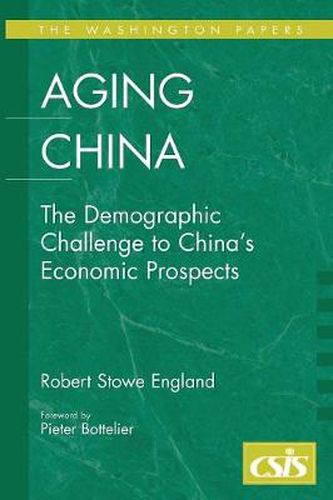Readings Newsletter
Become a Readings Member to make your shopping experience even easier.
Sign in or sign up for free!
You’re not far away from qualifying for FREE standard shipping within Australia
You’ve qualified for FREE standard shipping within Australia
The cart is loading…






China, the world’s most populous nation, will enter a period of rapid aging very shortly that will redefine the country. Between 2010 and 2040, the number of people 65 and older will rise from around 7% to between 25 and 30% of the population. As China ages, can it retain the youthful dynamism now driving it? Aging in developed societies and economies has been widely studied. In Japan and Western Europe, for example, we know that as populations age, their societies decline, leaving fewer younger workers to support the growing number of people who will become dependent on costly health care systems, or whose basic needs, such as food and shelter, will need to be subsidized. But less work has been done in assessing the potential impact of aging in developing countries, where the majority of people may be working poor, not middle class - as in the case of China. As China restructures its economy, the old benefits packages previously available are being replaced by a patchwork of benefits across a wide range of enterprises. This book is an effort to try to capture the broad outlines of the significant economic, market, social, and demographic factors that will shape the future of China as its population ages.
$9.00 standard shipping within Australia
FREE standard shipping within Australia for orders over $100.00
Express & International shipping calculated at checkout
China, the world’s most populous nation, will enter a period of rapid aging very shortly that will redefine the country. Between 2010 and 2040, the number of people 65 and older will rise from around 7% to between 25 and 30% of the population. As China ages, can it retain the youthful dynamism now driving it? Aging in developed societies and economies has been widely studied. In Japan and Western Europe, for example, we know that as populations age, their societies decline, leaving fewer younger workers to support the growing number of people who will become dependent on costly health care systems, or whose basic needs, such as food and shelter, will need to be subsidized. But less work has been done in assessing the potential impact of aging in developing countries, where the majority of people may be working poor, not middle class - as in the case of China. As China restructures its economy, the old benefits packages previously available are being replaced by a patchwork of benefits across a wide range of enterprises. This book is an effort to try to capture the broad outlines of the significant economic, market, social, and demographic factors that will shape the future of China as its population ages.